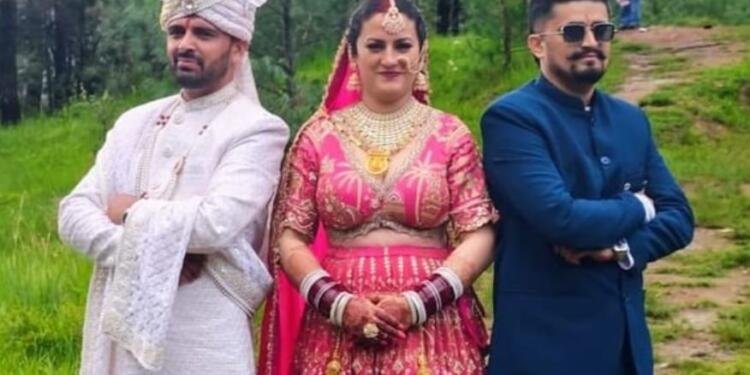📰 What is the story?
In July 2025, a wedding photo from Himachal Pradesh’s Shillai village went viral. Sunita Chauhan, dressed as a bride, was seen sitting between two grooms—brothers Pradeep and Kapil Negi. Their marriage wasn’t a gimmick or media stunt—it was a revival of an old tribal custom known as Jodidaran, practiced by the Hatti tribe.
This was not an isolated case. The Hatti community has witnessed five such polyandrous marriages in just six years, showing that the tradition, though fading, still finds support in some parts of the region.
🕊️ What is the custom?
Jodidaran, also known as ‘Ujla Paksh’ or ‘Draupadi Pratha’, is a form of fraternal polyandry, where one woman marries multiple brothers. Practiced by the Hatti tribe (now officially recognized as a Scheduled Tribe), this tradition has deep cultural and economic roots:
- Land Protection: Scarce farmland in the hilly region is kept undivided when brothers share a wife. This helps families avoid splitting property into unviable portions.
- Family Unity & Cooperation: A shared wife ensures that the family remains intact, resources are pooled, and brothers remain close-knit.
- Economic & Physical Security: In remote areas with difficult terrain, a larger family unit offers better protection and labor support.
Weddings are celebrated with traditional three-day rituals called ‘Jajda’, with spiritual offerings like ‘Seenj’ (holy water and jaggery), reflecting the tribe’s sacred beliefs.
⚖️ What does the law of the land say?
Legally, polyandry is not recognized under Indian marriage laws:
- The Hindu Marriage Act (1955) and the Special Marriage Act do not permit polyandrous unions.
- Under the Bhartiya Nyaya Sanhita, such arrangements may even attract criminal liability.
However, there’s a constitutional exception:
- Article 342 allows Scheduled Tribes to follow their customary laws, unless explicitly overridden by the state.
- The Himachal Pradesh High Court has in the past recognized such unions based on village records (Wajib-ul-Arz) for purposes like inheritance.
- Even the Uttarakhand Uniform Civil Code (2025) excludes Scheduled Tribes from its purview, protecting traditions like this in regions such as Kinnaur and Jaunsar-Bawar.
So, while Jodidaran isn’t legally a “marriage”, in tribal areas it’s treated with cultural legitimacy, especially in revenue and inheritance matters.
🔍 Sociologists on Polyandry in India
Sociologists have long studied polyandry in the Himalayan belt—including regions like Kinnaur, Jaunsar, and Trans-Giri—where the practice was shaped by environmental, social, and economic conditions.
Key insights from experts include:
- Resource Management: Sharing one wife was a practical solution in places with scarce land and tough terrain, allowing families to remain united and financially stable.
- Demographic Reality: Skewed sex ratios and harsh living conditions historically made polyandry more viable.
- Cultural Identity: For communities like the Hattis, polyandry isn’t just a practice—it’s a symbol of tribal distinctiveness.
Renowned sociologist Dr. Y.S. Parmar, who later became Himachal’s first Chief Minister, studied Himalayan polyandry extensively. He warned that while the system may serve practical needs, it can also reinforce patriarchal norms and suppress women’s autonomy.
Others, like Dr. O.P. Sharma, advocate for a more empathetic view:
“If live-in relationships are socially accepted, why condemn customs rooted in survival and tradition?”
💭 A Tradition at a Crossroads
The wedding of Sunita Chauhan and the Negi brothers brings an ancient tradition into sharp focus. While some hail it as a proud assertion of tribal identity, others raise valid concerns about its legal status and gender dynamics.
With increasing migration, education, and awareness, Jodidaran may slowly fade, but it continues to pose essential questions:
- Can India’s diverse legal and cultural landscape make space for such age-old traditions?
- Where do we draw the line between cultural autonomy and individual rights?
As the Supreme Court noted recently:
“Customs cannot remain stuck in time… but others cannot hide behind them to deprive rights.”
For now, in the misty mountains of Himachal, the bond of land, love, and legacy continues—between two brothers and one bride.


